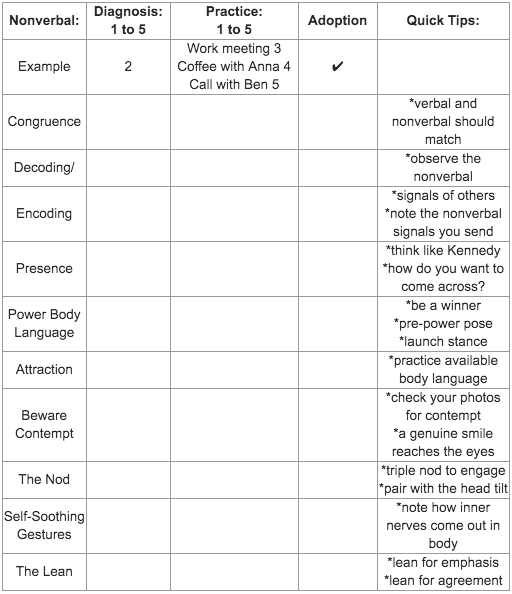Body Language Action Plan
Episode #10 of the course The secrets of body language by Vanessa Van Edwards
CONGRATULATIONS! You made it! Did you buy that cape? If so, tie it on, dance around, and party. You are officially a body language superhero!
Let’s take a moment to review what we’ve learned:
Day #1: 60-93% of our communication is nonverbal. Focus on your nonverbal cues and the nonverbal behavior of others as much as you do words.
Day #2: Reading body language is about decoding and encoding both the cues that you see and the signals you send.
Day #3: Presence is powerful. Kennedy showed tremendous confidence and presence in the debate against Nixon. Think like Kennedy in your social interactions.
Day #4: Unleash your inner winner with power body language. Pre-power pose before your next event and use your launch stance to keep your confidence up.
Day #5: Make a killer first impression and look for specific nonverbal signs to attract your perfect person.
Day #6: Contempt is the cardinal sin of profile photos. Avoid contempt by smiling genuinely.
Day #7: The triple nod and the head tilt increase engagement and connection with others.
Day #8: Comforting gestures make you look nervous and uncomfortable. Break your bad habits now.
Day #9: Use the power of the lean for emphasis, agreement, and partnership.
And today is all about your Body Language Action Plan. You didn’t think I’d leave you hanging now, did you?
1. Tackle one skill at a time
Reading body language, optimizing your own signals, and decoding facial expressions is kind of like seeing the world in high definition for the first time. It can be a little overwhelming to try everything all at once, so practice one skill at a time.
Learning happens in three stages:
• Awareness
• Discomfort
• Adoption
Awareness is the stage when you become “aware” of new information. You may have never heard of contempt or the power of the lean before this email course, but now you know. In this stage, the brain is understanding a new concept.
Discomfort is the hardest stage. This is when you’ve become aware of new information and you act on the information. Power posing for the first time or reminding yourself not to fidget at your desk may feel a little uncomfortable at first. But it’s totally worth it for…
Adoption. Adoption is the final stage in the learning process. This is when you have learned new information, acted on this information, and incorporated it into your daily routine so it feels like something you’ve always done.
Your brain is a muscle, and just like flexing your biceps at the gym, you can flex your brain. Maybe this week, you flex your attraction cues and next week you practice the triple nod. You may adopt some skills quickly, while others may take longer. Every person is different, so take your time, keep calm, and practice on.
And here’s a handy-dandy chart for practice. Print this email and fill it out as you go. Diagnosis is where you are now on this nonverbal skill (1 being “need a lot of work,” 5 being “I’ve got this”) and add in the places you’ve practiced each skill and your rating. Once you’ve reached a 4 or 5 for each skill, put a check in the Adoption field.
2. Find a body language buddy
The discomfort stage is way easier when you have someone else in the same boat. Share this course with a friend and support and encourage each other along the way. You can even practice your new skills with each other.
3. Test yourself
Take our Body Language Final Quiz to test what you’ve learned. Note any areas that you may need a little refresher on.
4. Bonus!
Check out Captivate: The Science of Succeeding with People for even more on nonverbal science.
Do you wish you could decode people? Do you want a formula for charisma? Do you want to know exactly what to say to your boss, your date or your networking partner? You need to know how people work.
Thank you for taking this journey with me!
Cheers,
Vanessa
P.S. We are constantly updating our Science of People blog with crazy research, ridiculous experiments, and kick-ass tips. Learn how to make every conversation count with our mini-course 3 Steps to Amazing Conversation.
Share with friends


